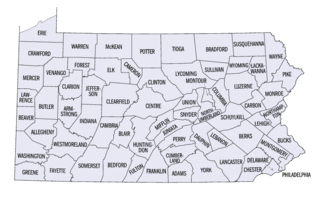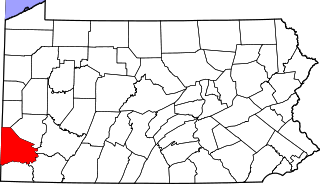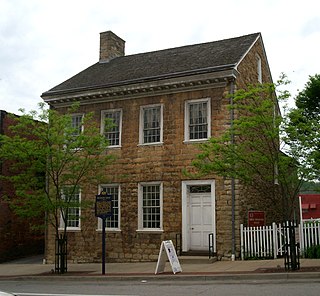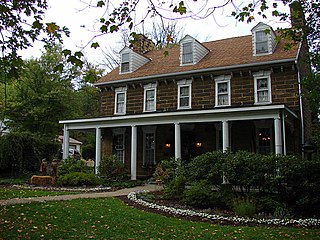
Washington County is a county in the Commonwealth of Pennsylvania, United States. As of the 2020 census, the population was 209,349. Its county seat is Washington. The county is part of the Greater Pittsburgh region of the state.

North Franklin Township is a township in Washington County, Pennsylvania, United States. The population was 4,826 at the 2020 census.

Washington is a city in, and the county seat of, Washington County, Pennsylvania, United States. The population was 13,176 at the time of the 2020 census. Part of the Pittsburgh metropolitan area in the southwestern part of the state, the city is home to Washington & Jefferson College and Pony League baseball.
LeMoyne–Owen College is a private historically black college affiliated with the United Church of Christ and located in Memphis, Tennessee. It resulted from the 1968 merger of historically black colleges and other schools established by northern Protestant missions during and after the American Civil War.

This is a list of properties and districts listed on the National Register of Historic Places in Pennsylvania. As of 2015, there are over 3,000 listed sites in Pennsylvania. All 67 counties in Pennsylvania have listings on the National Register.

This is a list of the National Register of Historic Places listings in Washington County, Pennsylvania.

A crematorium or crematory is a venue for the cremation of the dead. Modern crematoria contain at least one cremator, a purpose-built furnace. In some countries a crematorium can also be a venue for open-air cremation. In many countries, crematoria contain facilities for funeral ceremonies, such as a chapel. Some crematoria also incorporate a columbarium, a place for interring cremation ashes.

The David Bradford House is a historic house museum at 175 South Main Street in Washington, Pennsylvania. Completed in 1788, it was the home of David Bradford, a leader of the Whiskey Rebellion. It has both architectural and historic importance, and was designated a National Historic Landmark in 1983. It is open weekly between April and November, or by appointment.

Francis Julius LeMoyne was a 19th-century American medical doctor and philanthropist from Washington, Pennsylvania. Responsible for creating the first crematory in the United States, he was also an abolitionist, founder of Washington's first public library, co-founder of the Washington Female Seminary, and an instrumental benefactor to the LeMoyne Normal and Commercial School, to which he made a $20,000 donation in 1870.

The Edward G. Acheson House is a historic house at 908 West Main St. in Monongahela, Washington County, Pennsylvania, United States. Probably built about 1870, it is notable as the home of Edward G. Acheson (1856-1931), the inventor of carborundum, and as the likely site of its invention. It was designated a National Historic Landmark in 1976.

The F. Julius LeMoyne House is a historic house museum at 49 East Maiden Street in Washington, Pennsylvania. Built in 1812, it was the home of Dr. Francis Julius LeMoyne (1798–1897), an antislavery activist who used it as a stop on the Underground Railroad. LeMoyne also assisted in the education of freed slaves after the American Civil War, founding the historically black LeMoyne–Owen College in Memphis, Tennessee. His house, now operated as a museum by the local historical society, was designated a National Historic Landmark in 1997. It is designated as a historic public landmark by the Washington County History & Landmarks Foundation.

St. Peter's Kierch, also called the Old Kierch or St. Peter's Church, is a historic Lutheran church in Middletown, Dauphin County in the U.S. state of Pennsylvania. Construction began in 1767 and it was dedicated by Henry Muhlenberg in 1769. St. Peter's Kierch was used regularly until 1879 when a large church was completed. It was listed on the National Register of Historic Places in 1973.

Mingo Creek Presbyterian Church and Churchyard is a church and historic location in Washington County, Pennsylvania. It is located at the junction of Pennsylvania Route 88 and Mingo Church Road in Union Township, Washington County, Pennsylvania, near Courtney, Pennsylvania. It is a member of the Washington Presbytery.

The Roberts House is a historic building in Canonsburg, Pennsylvania, listed on the National Register of Historic Places. It is designated as a historic residential landmark/farmstead by the Washington County History & Landmarks Foundation. The Greater Canonsburg Heritage Society erected a historical marker near the house, which is the last remaining structure from Jefferson College.

The California Area Public Library is the public library serving California, Pennsylvania, and is a branch of the Washington County Library System. The library is located in the former Pennsylvania Railroad Passenger Station, which was listed on the National Register of Historic Places in 1979.

The Claysville "S" Bridge is a historic S bridge in Washington County, Pennsylvania. The bridge is made of stone and was a part of the Cumberland Road and helped transport wagons and stagecoaches amid the American westward expansion in the early 19th century. It passes over Buffalo Creek.

Cement City Historic District is a historic district in Donora, Pennsylvania. The district includes 80 Prairie School concrete residences built in 1916–17. The homes served as housing for employees of the American Steel and Wire Company. Poured-in-place concrete houses had become popular in large-scale housing developments at the time, partly thanks to promotion by Thomas Edison; the homes built in Donora used a newly patented construction method from the Lambie Concrete House Corporation. Building the houses required a combined 10,000 barrels of Portland cement.

Hill's Tavern is a historic building in Scenery Hill, Pennsylvania. It was heavily damaged by a fire that started shortly before midnight on August 17, 2015. For a period in the early 1900s, the inn was known as Central Hotel. Now called the Century Inn, it has been claimed to have been the oldest tavern in continuous use on the National Road, until the fire brought an end to its 221 years of continuous operation.

York Iron Company Mine is a historic iron mine site located at North Codorus Township, York County, Pennsylvania. The underground mine was originally opened in 1854, with additional openings dug in 1876–1877. The mine remained in operation until 1888.

The Reading Furnace Historic District is a national historic district that is located in Warwick Township and East Nantmeal Township, Chester County, Pennsylvania.
























